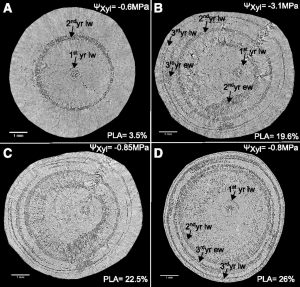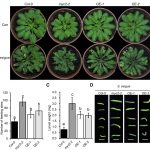On the Inside: Recovery from Drought Stress in Scots Pine
 Trees often do not die during a drought but may succumb weeks to years later. Drought-induced damage may persist by incomplete recovery of plant hydraulic and metabolic processes, making trees vulnerable to pests and pathogen attacks. In the case of conifers, which have no vessels and low levels of parenchyma in their xylem tissue, a growing body of literature indicates a lack of refilling capability in most conifer species following the drought-induced production of xylem embolisms. The main strategy of conifers confronted with drought may be to prevent embolism by early stomatal closure. Alternatively, they may regain hydraulic conductivity by quickly growing new xylem during recovery. Scots pine (Pinus sylvestris) is one of the most abundant conifers worldwide although its resilience to extreme drought is limited. To better understand post-drought hydraulic recovery in this species, Rehschuh et al. (10.1104/pp.20.00407) investigated stress and recovery dynamics of leaf gas exchange, non-structural carbohydrates (NSC), and hydraulic properties in 2.5-year-old Scots pine seedlings. They quantified the degree of xylem embolism by combining in vivo X-ray microtomography during drought progression, as well as short term (2 days), and long-term (4 weeks) recovery. The watering of seedlings was withheld until their stomata closed and their xylem water potential (ΨXylem) declined to -3.2 MPa on average, causing a 46% loss of stem hydraulic conductivity (Ks). Following re-watering, a gradual recovery of leaf gas exchange to 50 to 60% of control values was observed. This partial recovery indicates drought induces hydraulic impairment. Although ΨXylem recovered to close to control values within 2 days, both micro-CT and other types of measurements revealed no recovery of Ks. Moreover, the authors did not find indications for NSC reserves limiting hydraulic recovery. These findings demonstrate that Scots pine is able to survive severe drought and to partially recover. Presumably, xylem development during the next growing season compensates for the long-term hydraulic impairment that follows drought. Such drought-induced legacy effects are important when considering vegetation responses to extreme events.
Trees often do not die during a drought but may succumb weeks to years later. Drought-induced damage may persist by incomplete recovery of plant hydraulic and metabolic processes, making trees vulnerable to pests and pathogen attacks. In the case of conifers, which have no vessels and low levels of parenchyma in their xylem tissue, a growing body of literature indicates a lack of refilling capability in most conifer species following the drought-induced production of xylem embolisms. The main strategy of conifers confronted with drought may be to prevent embolism by early stomatal closure. Alternatively, they may regain hydraulic conductivity by quickly growing new xylem during recovery. Scots pine (Pinus sylvestris) is one of the most abundant conifers worldwide although its resilience to extreme drought is limited. To better understand post-drought hydraulic recovery in this species, Rehschuh et al. (10.1104/pp.20.00407) investigated stress and recovery dynamics of leaf gas exchange, non-structural carbohydrates (NSC), and hydraulic properties in 2.5-year-old Scots pine seedlings. They quantified the degree of xylem embolism by combining in vivo X-ray microtomography during drought progression, as well as short term (2 days), and long-term (4 weeks) recovery. The watering of seedlings was withheld until their stomata closed and their xylem water potential (ΨXylem) declined to -3.2 MPa on average, causing a 46% loss of stem hydraulic conductivity (Ks). Following re-watering, a gradual recovery of leaf gas exchange to 50 to 60% of control values was observed. This partial recovery indicates drought induces hydraulic impairment. Although ΨXylem recovered to close to control values within 2 days, both micro-CT and other types of measurements revealed no recovery of Ks. Moreover, the authors did not find indications for NSC reserves limiting hydraulic recovery. These findings demonstrate that Scots pine is able to survive severe drought and to partially recover. Presumably, xylem development during the next growing season compensates for the long-term hydraulic impairment that follows drought. Such drought-induced legacy effects are important when considering vegetation responses to extreme events.



